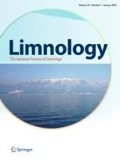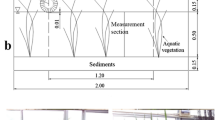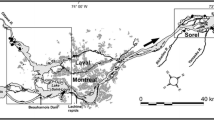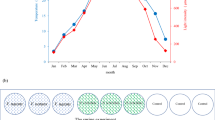Abstract
To identify the causes of the rapid expansion of the semi-emergent Phalaris arundinacea L. community in a nutrient-loaded river, we investigated the factors that determine the distribution of the Phalaris and other aquatic macrophyte communities and the shoot growth of P. arundinacea. The Phalaris community was distributed through areas with high organic nitrogen (Org-N), total phosphorus (T-P), PO4-P and suspended solids (SS) concentrations and low dissolved oxygen (DO). P. arundinacea shoots grow better in deep mud and high SS and T-P, all of which were strongly correlated with slower stream currents. Accordingly, although the concentration of total nitrogen constantly increased from 1985 to 1998, the determining nutrient for the expansion of the Phalaris community and P. arundinacea shoot growth stimulation was phosphorus rather than nitrogen. The Phalaris community increased rapidly between 1991 and 1996, when brief but prominent loadings of phosphorus were observed. We concluded that the Phalaris community was restricted due to phosphorus deficiency under nitrogen excess until 1991 and subsequently rapidly expanded over the channel due to the temporary excess phosphorus present during this period. Thereafter, the rapid expansion of the Phalaris community was maintained by the clogging effect of the floating mats formed by shoots and their remains of P. arundinacea, which results in slower currents. A slower current resulted in low DO, the sedimentation of degraded plant remains (high Org-N), and the adsorption of phosphorus by suspended matter (high SS and T-P). The anaerobic conditions caused by low oxygen and the accumulation of decomposable organic matter ensure the continuous development of the Phalaris community through the release of soluble phosphorus from the sediment.








Similar content being viewed by others
References
Adams CR, Galatowitsch SM (2006) Increasing the effectiveness of Reed canary grass (Phalaris arundinacea L.) control in wet meadow restorations. Restor Ecol 14:441–451
Allan JD (2004) Landscapes and riverscapes: the influence of land use on stream ecosystems. Annu Rev Ecol Evol Syst 35:257–284
Arts GHP (2002) Deterioration of atlantic soft water macrophyte communities by acidification, eutrophication and alkalinisation. Aquat Bot 73:373–393
Asaeda T, Trung VK, Manatunge J, Bon VT (2001) Modelling macrophyte–nutrient–phytoplankton interactions in shallow eutrophic lakes and the evaluation of environmental impacts. Ecol Eng 16:341–357
Baattrup-Pedersen A, Riis T (1999) Macrophyte diversity and composition in relation to substratum characteristics in regulated and unregulated Danish streams. Freshwat Biol 42:375–385
Barendregt A, Bio AMF (2003) Relevant variables to predict macrophyte communities in running waters. Ecol Model 160:205–217
Bronmark C, Hansson L (2005) The biology of lakes and ponds, 2nd edn. Oxford University Press, Oxford
Cotton JA, Wharton G, Bass JAB, Heppell CM, Wotton RS (2006) The effects of seasonal changes to in-stream vegetation cover on patterns of flow and accumulation of sediment. Geomorphology 77:320–334
Demars BOL, Harper DM (2005) Distribution of aquatic vascular plants in lowland rivers: separating the effects of local environmental conditions, longitudinal connectivity and river basin isolation. Freshwat Biol 50:418
Dubois JP (1994) Uptake of macroelements by the helophyte Phalaris arundinacea L. Aquat Sci 56:70–80
Fraser LH, Carty SM, Steer D (2004) A test of four plant species to reduce total nitrogen and total phosphorus from soil leachate in subsurface wetland microcosms. Bioresour Technol 94:185–192
Green EK, Galatowitsch SM (2002) Effects of Phalaris arundinacea and nitrate-N addition on the establishment of wetland plant communities. J Appl Ecol 39:134–144
Greulich S, Bornette G (2003) Being evergreen in an aquatic habitat with attenuated seasonal contrasts—a major competitive advantage? Plant Ecol 167:9–18
Gurnell AM, van Oosterhout MP, de Vlieger B, Goodson JM (2006) Reach-scale interactions between aquatic plants and physical habitat: River Frome, Dorset. River Res Appl 22:667–680
Gusewell S (2005) Responses of wetland graminoids to the relative supply of nitrogen and phosphorus. Plant Ecol 176:35–55
Hauer FR, Lamberti GA (2006) Methods in stream ecology, 2nd edn. California Academic Press, San Diego
Herr-Turoff A, Zedler JB (2005) Does wet prairie vegetation retain more nitrogen with or without Phalaris arundinacea invasion? Plant Soil 277:19–34
Herr-Turoff A, Zedler JB (2007) Does morphological plasticity of the Phalaris arundinacea canopy increase invasiveness? Plant Ecol 193:265–277
Hill MO (1979) TWINSPAN—a FORTRAN program for arranging multivariable data in an ordered two-way table by classification of the individuals and attributes. Ecology and Systematics, Cornell University, Ithaca
Hokkaido Government (2007) Nature restoration of Bibi River Plan document. Hokkaido Government, Hokkaido (in Japanese)
Hokkaido National Agricultural Experiment Station (1985) Classification and distribution of arable soils in Hokkaido. Hokkaido National Agricultural Experiment Station, Sapporo (in Japanese)
Horne AJ, Goldman CR (1994) Limnology, 2nd edn. McGraw-Hill, New York
Japan River Association (2004) The year book of water quality of the Japanese river. Japan River Association, Tokyo (in Japanese)
Japanese Industrial Standards Committee (2008) Testing methods for industrial wastewater (JIS K 0102). Japanese Industrial Standards Committee, Tokyo
Johnson LB, Richardes C, Host GE, Arthur JW (1997) Landscape influences on water chemistry in Midwestern stream ecosystems. Freshwat Biol 37:193–208
Kadono Y (1994) Aquatic Plants of Japan. Bun-ichi Sogo Shuppan, Tokyo (in Japanese)
Kao JT, Titus JE, Zhu W (2003) Differential nitrogen and phosphorus retention by five wetland plant species. Wetlands 23:979–987
Kercher SM, Zedler JB (2004) Flood tolerance in wetland angiosperms: a comparison of invasive and noninvasive species. Aquat Bot 80:89–102
Kuhar U, Gregorc T, Rencelj M, Sraj-Krzic N, Gaberscik A (2007) Distribution of macrophytes and condition of the physical environment of streams flowing through agricultural landscape in north-eastern Slovenia. Limnologica 37:146–154
Lavergne S, Molofsky J (2004) Reed canary grass (Phalaris arundinacea) as a biological model in the study of plant invasions. Crit Rev Plant Sci 23:415–429
Lavoie C, Dufresne C, Delisle F (2005) The spread of reed canarygrass (Phalaris arundinacea) in Quebec: a spatio-temporal perspective. Ecoscience 12:366–375
Lefor MW (1987) Phalaris arundinacea L. (reed canary grass-Gramineae) as a hydrophyte in Essex, Connecticut, USA. Environ Manag 11:771–773
Lenat DR (1984) Agriculture and stream water quality—a biological evaluation of erosion control practices. Environ Manag 8:333–343
McCune B, Mefford MJ (1999) PC-ORD for Windows v.4.17. MjM Software Design, Gleneden Beach
Mesters CML (1995) Shifts in macrophyte species composition as a result of eutrophication and pollution in Dutch transboundary streams over the past decades. J Aquat Ecosyst Health 4:295–305
Miller RC, Zedler JB (2003) Responses of native and invasive wetland plants to hydroperiod and water depth. Plant Ecol 167:57–69
Ootaki S, Ishito C (1980) Illustrated Japanese water plants. Hokuryukan, Tokyo (in Japanese)
Pedersen TCM, Baattrup-Pedersen A, Madsen TV (2006) Effects of stream restoration and management on plant communities in lowland streams. Freshwat Biol 51:161–179
Picard CR, Fraster LH, Steer D (2005) The interacting effects of temperature and plant community type on nutrient removal in wetland microcosms. Bioresour Technol 96:1039–1047
Ponnamperuma FN (1972) The chemistry of submerged soils. Adv Agron 24:29–96
Regina TB (1992) The influence of substratum and water velocity on growth of Ranunculus aquatilis L. (Ranunculaceae). Aquat Bot 42:351–359
Riis T, Sand-Jensen K (2001) Historical changes in species composition and richness accompanying perturbation and eutrophication of Danish lowland streams over 100 years. Freshwat Biol 46:269–280
Sand-Jensen K, Riis T, Vestergaad O, Larsen SE (2000) Macrophyte decline in Danish lakes and streams over the past 100 years. J Ecol 88:1030–1040
Sparling JH (1966) Studies on the relationship between water movement and water chemistry in mires. Can J Bot 44:747–758
Ter Braak CJF (1986) Canonical correspondence analysis: a new eigenvector technique for multivariate direct gradient analysis. Ecology 67:1167–1179
Tomakomai Weather Station (2010) Past rainfall, temperature and precipitation data at Tomakomai Weather Station. http://www.data.jma.go.jp/obd/stats/etrn/index.php, cited 3 June 2010
Ueyama Y, Kubota A (2009) Exploration and collection of Kusayoshi (Phalaris arundinacea L.) in Tohoku Region. Annu Rep Explor Introd Plant Genet Resour 25:25–28 (in Japanese)
Westwood CG, Teeuw RM, Wade PM, Holmes NTH, Guyard P (2006) Influences of environmental conditions on macrophyte communities in drought-affected headwater streams. River Res Appl 22:703–726
Zar JH (1999) Biostatistical analysis, 4th edn. Prentice-Hall, Upper Saddle River
Acknowledgments
This study was supported by funds provided by grants in aid for scientific research (numbers 18201008, 19208013) from the Ministry of Education, Science and Culture, Japan. The authors thank Prof. Noriaki Yogo (Hokkai-Gakuen University) for supplying the location of the discharge data.
Author information
Authors and Affiliations
Corresponding author
Rights and permissions
About this article
Cite this article
Katagiri, K., Yabe, K., Nakamura, F. et al. Factors controlling the distribution of aquatic macrophyte communities with special reference to the rapid expansion of a semi-emergent Phalaris arundinacea L. in Bibi River, Hokkaido, northern Japan. Limnology 12, 175–185 (2011). https://doi.org/10.1007/s10201-010-0335-z
Received:
Accepted:
Published:
Issue Date:
DOI: https://doi.org/10.1007/s10201-010-0335-z




